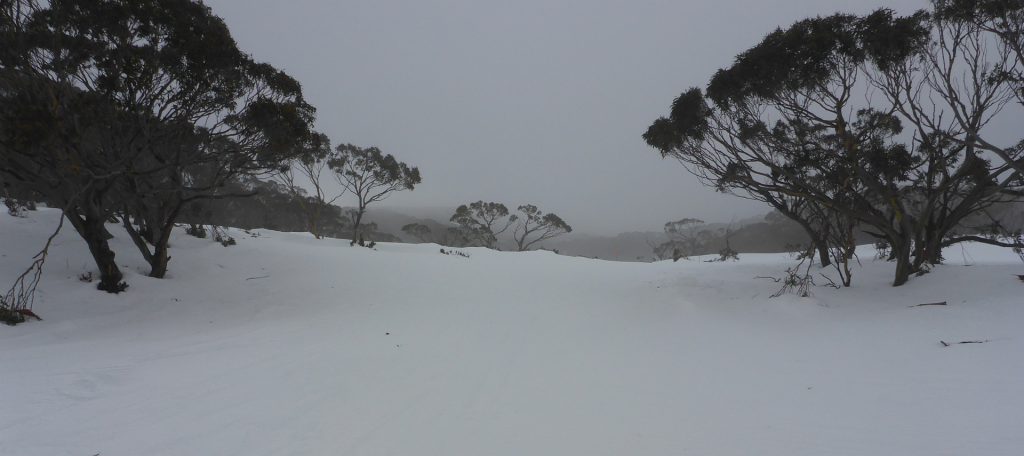 I have recently been upgrading my camping skills to include snow camping after many years of day skis and hikes in the snow. I recently attended an Alpine Search and Rescue training weekend in some adverse conditions (lots of snow and wind) which has boosted my confidence in these conditions. Consequently I decided to repeat my trip to the Baw Baw plateau in winter, but this time starting from Mt Baw Baw resort and trying out winter hammock camping at the same time.
I have recently been upgrading my camping skills to include snow camping after many years of day skis and hikes in the snow. I recently attended an Alpine Search and Rescue training weekend in some adverse conditions (lots of snow and wind) which has boosted my confidence in these conditions. Consequently I decided to repeat my trip to the Baw Baw plateau in winter, but this time starting from Mt Baw Baw resort and trying out winter hammock camping at the same time.
The goal was to activate Mt St Phillack and Talbot Peak on the Saturday, camp overnight near the latter and then walk back the same way on the Sunday. I chose to use snow shoes rather than skis as my cross country skiing skills are still limited with a 20kg pack. The track between Mt St Phillack and Talbot Peak also has sections that would be a bit tricky to negotiate on skis, and being solo, I decided the risk of injury would be excessive.
I was up at 5:30am on Sat morning and on the road by 6:00, arriving at Baw Baw resort around 8:30. The forecast for the weekend was for snow showers on both days with a moderate (20-30 km/h) wind and up to 10cm of snow on Saturday and 1-2cm on Sunday. Forecast maximum on Saturday around 1 degree C and overnight low on Sat night down to -5 degrees C. Not totally ideal, but given that the whole plateau is forested, acceptable.
After completing the trip intentions book at the resort information office, I donned my snow shoes and set off up Mueller’s track. The snow was reasonably packed and hadn’t had anything fresh for a few days judging by the amount of bark and leaves on the ground.
Navigation to Mt St Phillack is easy as there’s a continuous pole line with track markers all the way from Baw Baw resort to St Gwinear car park. I left the resort at 8:45 and arrived at Mt St Phillack just after 10am, well ahead of schedule. The thing that immediately struck me was the snow depth compared to previous years – the cairn was almost buried!
I set up the station and got on the air quickly given the length of walking still to go. As usual, I couldn’t get a data connection from the summit and so resorted to the Parks’n’Peaks SMS gateway to spot. The wind was cold, so I operated from inside my bothy bag to keep warm sitting on my foam mat.
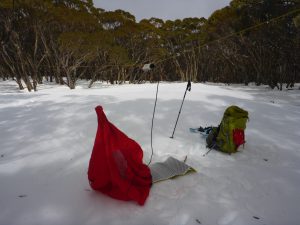
Operating at Mt St Phillack in a bothy bag – if you look carefully you can see the top of the cairn…
It wasn’t long before I had 10 contacts in the log including three S2S with Peter VK3ZPF (Mt Macedon), Gerard VK2IO (VK2/IL-006) and Bernard VK2IB (on VK2/RI-003). A good start to the day.
The original plan was to eat lunch here, but as it was only 11:00 and I wan’t hungry, I decided to push on given the 8km I still had to walk.
As I walked, the snow showers arrived, but unfortunately, the temperature was a bit too warm and the snow was very wet. I kept warm easily enough, but gradually everything got damp which I knew could be a problem later.
The track descends from the summit around 1570m altitude down to the saddle at 1340m. There was still plenty of snow in the saddle, but it wasn’t as deep and there were plenty of places where I sank deep into it despite the snow shoes.
Climbing back up the 200m vertical to Talbot Peak was just hard work! I made a couple of minor navigation errors which probably added only a few hundred metres to the walk. On the second one, I mistook a false summit for Talbot peak and headed off the track to where I thought I’d find the trig point only to realise my mistake.
At this point I realised that I’d been walking way too long without food and I was not thinking clearly – not good when you are wet and tired. I pulled out my bothy bag, hopped inside for food and a rest and a careful look at the map. I quickly realised my mistake and so after a 20 min break, resumed the last 850m to the actual summit.
When I arrived at the trig point, it was snowing quite heavily and with the wind I realised that I was going to need more than a bothy bag to keep warm given the sodden clothes I was now wearing. So I set up my hammock tarp in a spot that was reasonably protected from the wind.
Usually with a tarp, it is pitched such that the bottom edge is perhaps 50cm above the ground. However, I wanted good wind protection, so took advantage of the fact that snow is easy to dig. I pitched it right down to the snow level and then dug out a decent sized pit under it (which also served to warm me up!)
I also cut myself a seat in the closed end of the tarp to make a comfortable operating position. I set up the antenna and radio and finally got on the air about 90 mins after my alerted time. I was rewarded with another 10 contacts, including Warren ZL2AJ/M and Paul VK5PAS also operating the special event call of VI5MARCONI celebrating the centenary of the first radio communication between Australia and the UK.
After successfully activating the second summit, it was time to focus on preparing for what would be a very cold night. I started with making myself a hot cup of soup and then set up my hammock and improved the seal of the tarp by building up the snow around three sides.
The temperature had dropped significantly which was a good thing as the snow that was now falling was quite dry and the humidity level dropped enough that I knew I’d be able to get some things dry overnight.
After a fairly substantial hot meal and with a dry down mid-layer added, I felt quite warm and well recovered from the days substantial exercise. I spent the next hour or so melting snow to refill my water bottles and preparing my bedding.
I was in my hammock by 8:30 with a Nalgene water bottle full of hot water to thaw out my toes. I decided to sleep in most of my day wear except for the outer waterproof jacket and outermost mid-layer which was a bit too wet and had been replaced with the down jacket. All the layers were damp, but by sleeping in them under my down quilt, I knew they would be substantially drier by morning.
I slept really well – about 9.5 hours – waking up to -5 degrees C and no more snowfall. It was a struggle to force myself out of the warm cocoon and jam my feet into frozen leather boots! My clothing had mostly dried as predicted and so I knew I would be warm enough for the hike back. The quilts of course were now quite damp having absorbed most of the moisture, so it was a good thing I wasn’t planning a second night out!
After a hot muesli breakfast, I packed up camp and set off on the 12.4km hike back to the car. The walking was much easier on the 2nd day as the snow had frozen solid and had a soft layer of fresh powder on top that together supported the snow shoes much better.
Most of the way I could follow my tracks from the day before, but in places, they had been totally covered with fresh snow. Navigation isn’t too hard as you are essentially walking directly north on a wide ridge line.
I made it back to the car in just over 4 hours with rather sore feet and legs. It’s a very decent hike of 12.4km each way, so nearly 25 km in 2 days. Walking in snow shoes is not much harder than normal hiking, however you have almost and extra kilogram on each foot which needs to be lifted with every step, so it IS more tiring.
It was a challenging 2 days, but I’m very happy with the winter hammock camping and the satisfaction of having activated both peaks in one trip in winter.
Here’s a few more photos:

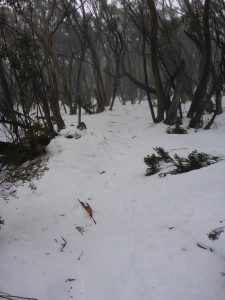
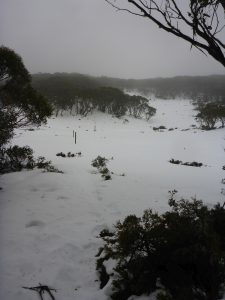
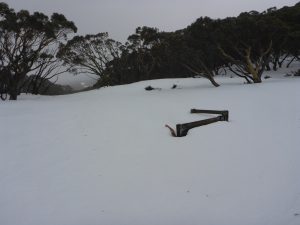
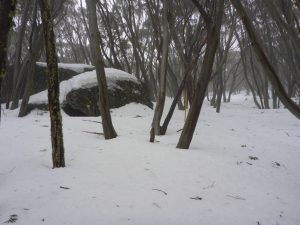
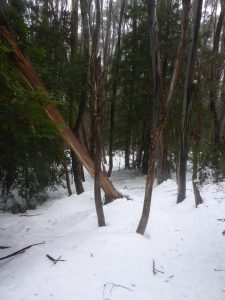
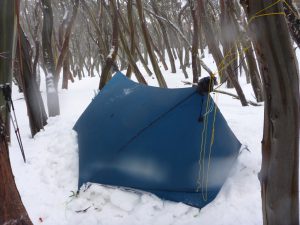
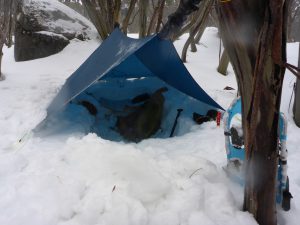
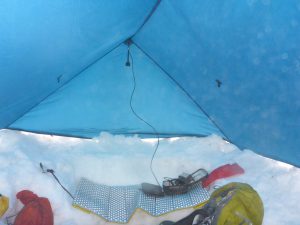
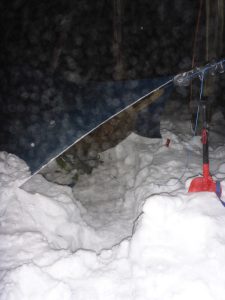
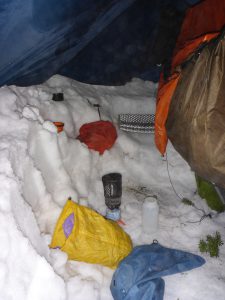
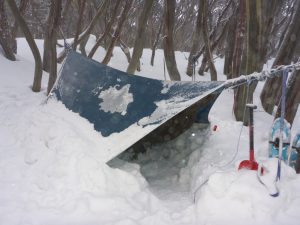
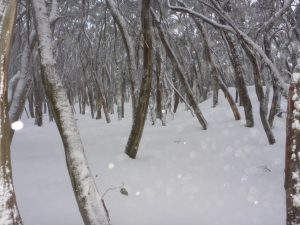
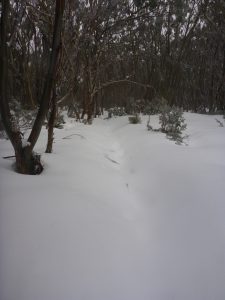
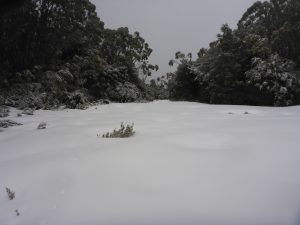
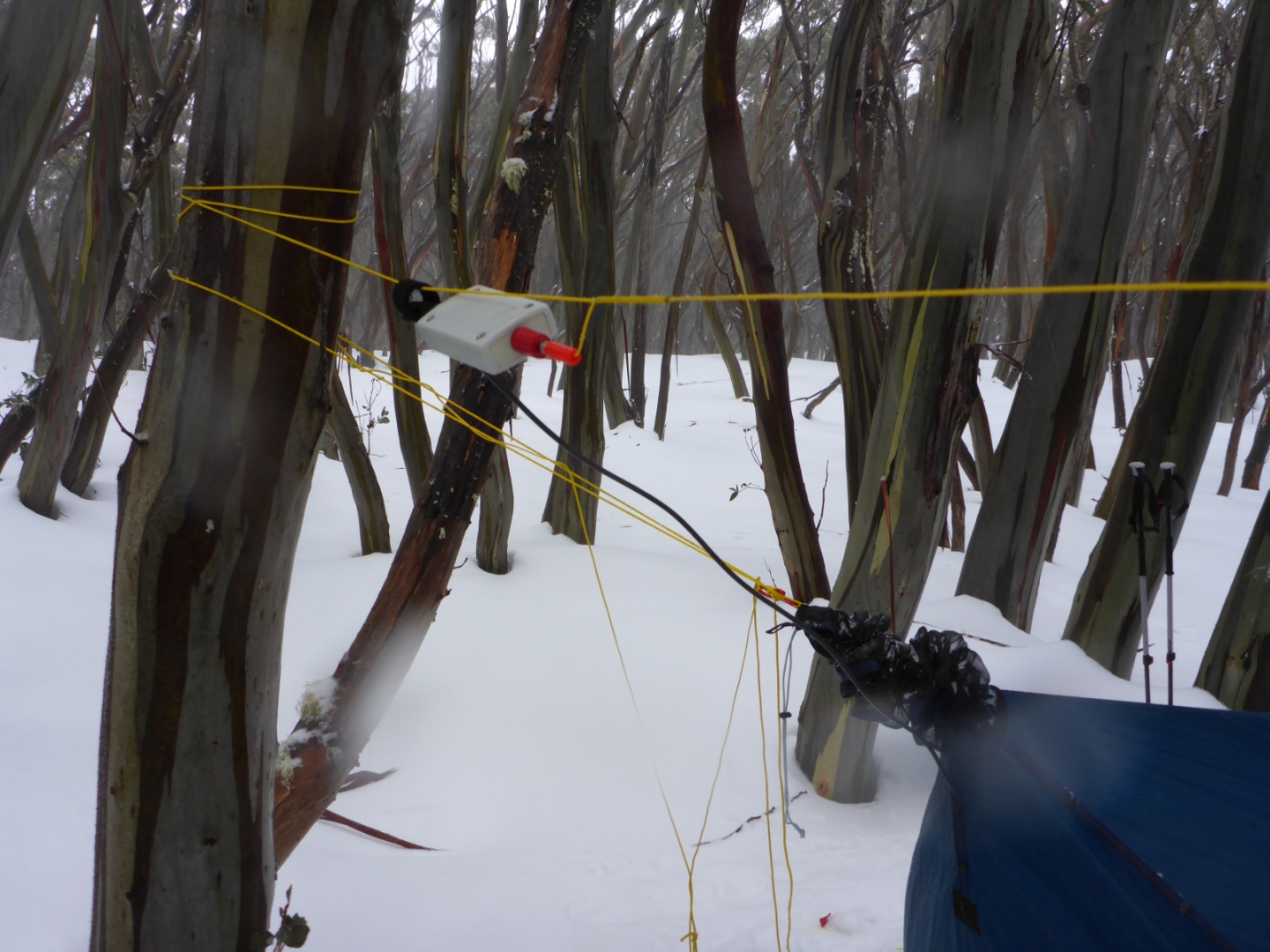
David,
It looks a little chilly……. thanks for all your blogs, always a good read.
Cheers,
Garry VK2GAZ
Thanks Garry.
Inspiring. My first experience of snow was an overnight camp out the back of Mt Baw Baw in scouts (45 years ago). So I have some idea of the conditions you camped in. Thankfully we only had 1 or 2 k’s walk back to the village. We certainly weren’t as well prepared as you, although I was lucky enough to have a down sleeping bag – a bit of a rarity at the time. But we ended up all wet and freezing cold, and very sleep deprived by the next morning. No way could we have walked 12km back!
I listened out for most activations on 20 and 40, but my current home setup wasn’t good enough to hear most thru the noise.
Great to read this other aspect of your activation, and glad to hear that the effort paid off. Good job. Thanks for sending the link to your blog. 73.
Thanks Alan, glad you enjoyed it.
Hello David
Thanks for the description of camping in the snow. I have never had that experience. Your post, as is usual, is really interesting and the photos great. I was pleased I had the contact with you from VK3/VT-006, Mount Saint Phillack. Conditions have been pretty poor to marginal on 40m from VK3. Once again thanks for writing a blog.
73
John D VK5BJE/VK5PF
Thanks John.
Great effort David. That’s a lot of snow! I looked for the Mt Saint Phillack cairn but couldn’t see it. Camp Saddle looks unrecognizable. Good luck with the final ascent (to MG). VK3HN.
Thanks Paul.